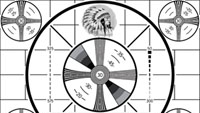A test pattern for DTV

Making its original debut in 1939, it seems only fitting that the legendary tried and true Indian Head test pattern (See Figure 1), originally developed by RCA, is now being replaced by a test pattern developed by Sarnoff. Originally founded as RCA Laboratories, it was the advanced research and development center for TV pioneer RCA. It was subsequently renamed the David Sarnoff Research Center (DSRC), and, with the acquisition by GE in 1986 and the subsequent breakup of RCA, DSRC became a separate entity called the Sarnoff Labs.
But, let's go back to the present and the era of digital television. Along with the advancements in technology is the inherent complexity associated with those advancements. If you think about it, examples abound all around you. Digital television is not an exception to this rule. From the original capture of content and throughout the various stages of processing and ultimately transmission of that content, the opportunity to introduce errors into the bit stream that represents the original content is manifold. The simplicity of analog video and transmission is a bygone, much like bandstand music emanating from a public park on a Sunday afternoon. As an aid to recognizing and solving the problems that can be introduced by the complexities of digital video, Sarnoff has developed an extremely comprehensive DTV test pattern called the Visualizer. (See Figure 2.)
An apt name, the Visualizer can reveal potential problems that may have been introduced by the various workflow processes to which the content was subjected. My own personal pet peeve, lip sync problems, can not only be identified, but also the offset from video can be precisely measured simply by viewing which of the “sprocket holes” in the lower portion of the test pattern is white. The solution is simple but effective.
Notice the offset color bars in the test pattern? The ramps in the green and magenta bars allow you to easily check 4:2:2 and 4:2:0 chroma sampling phase. Does the colorimetry of the content not seem quite right? The color spaces of HD standard Rec. 709 and SD standard Rec. 601 are different. If content conversions between HD and SD are not appropriately matrixed, the end result of the process is a color matrix mismatch, and it is instantly identifiable using the DTV test pattern. Are there strange motion artifacts in the content? A common cause is field dominance errors, which are also easily identifiable with the Visualizer.
Those mentioned above are just a few of the more commonly identified problems that this new test pattern can help you quickly spot. In addition, it can help you discover compression artifacts, linearity and gamma, and dropped frames, along with another dozen potential DTV problems.
Before retiring my familiar Indian friend, the engineer who developed the Visualizer conducted a demo for me, and I was impresed. He referred to it as his DTV Swiss Army knife. Victorinox, the originator and manufacturer of the Swiss Army knife, achieved one of its highest accolades when, in recognition of its unique design, New York's Museum of Modern Art (MOMA) added a Swiss Army knife to its collection. The Visualizer may not make it to the MOMA, but it may find a welcome home in TV stations and facilities.
Anthony R. Gargano is a consultant and former industry executive.
Send questions and comments to:anthony.gargano@penton.com
Get the TV Tech Newsletter
The professional video industry's #1 source for news, trends and product and tech information. Sign up below.
